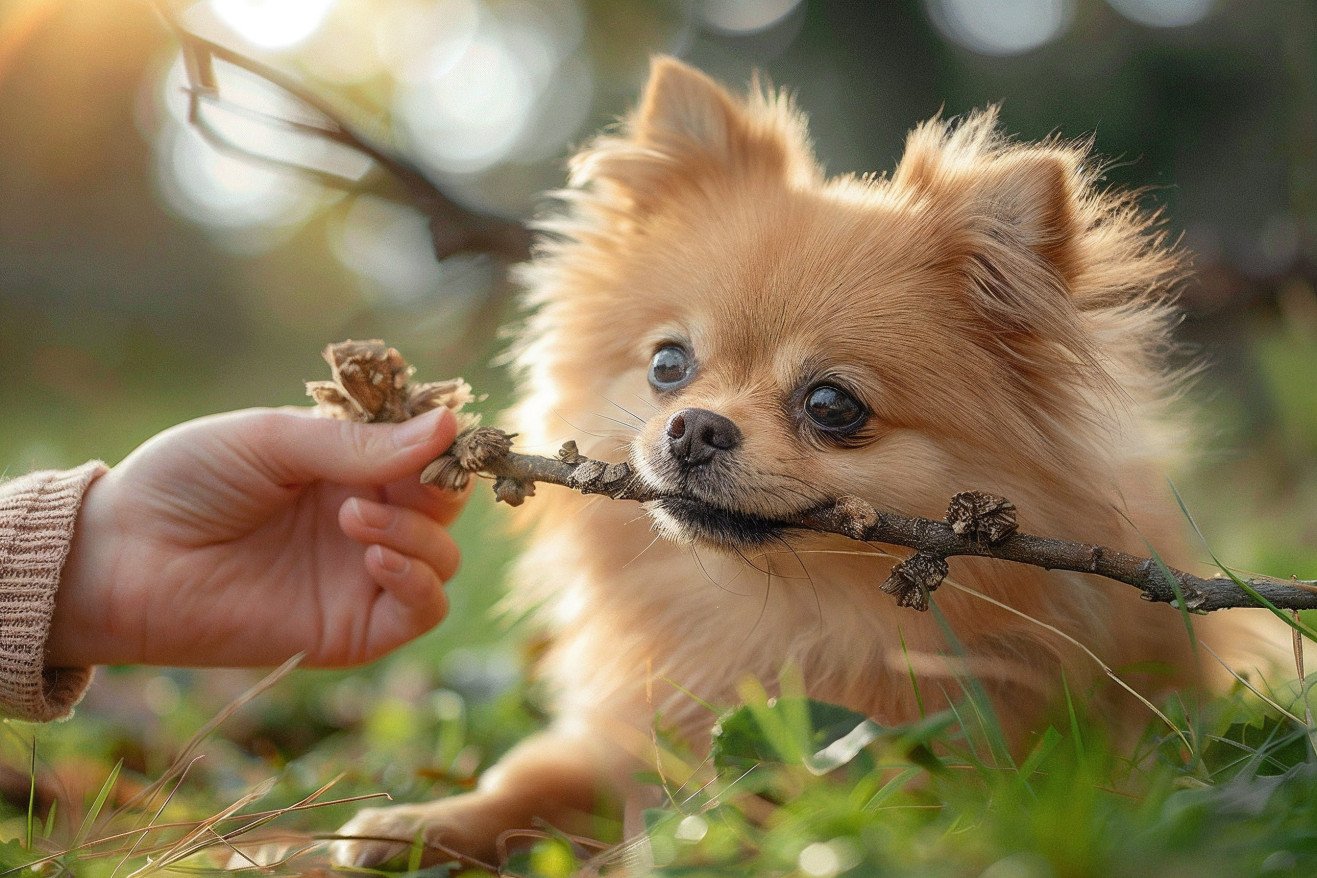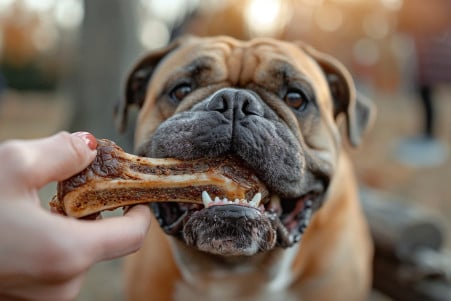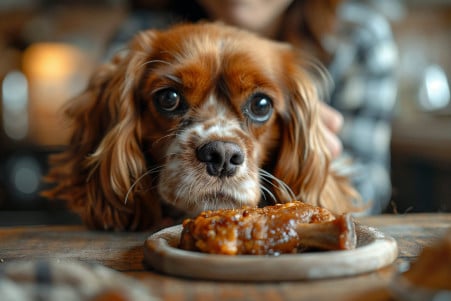Can Dogs Eat Sticks? The Dangers of This Common Behavior
5 April 2024 • Updated 5 April 2024

If you have a dog, you've probably witnessed your furry friend gnawing on a stick at some point. But is it OK for dogs to eat sticks? No, dogs should not eat sticks. Sticks can splinter and cause cuts or obstructions in the mouth, throat, or digestive system. The sharp edges can puncture internal organs, while smaller stick pieces pose a choking hazard. Even "harmless" chewing can wear down their teeth over time. It's best to provide safe dog chew toys instead.
We'll explore research from veterinarians and insights from dog health professionals to find out exactly why dogs eating sticks and branches is so dangerous. We'll learn about the potential injuries that can result from this behavior, the symptoms of blockages to look out for, and how to stop your dog from eating sticks. Armed with this knowledge, you can protect your pet from inadvertently swallowing these hazardous items while playing or walking.
Can dogs eat sticks?
Potential Injuries and Health Complications
Splinters from sticks can cut the gums, mouth, throat, and digestive system, leading to pain and an increased risk of infection, notes WagWalking. Meanwhile, swallowed sticks are even more problematic, as they can puncture or block the intestines, which can lead to severe health issues. Symptoms of an intestinal blockage include vomiting, loss of appetite, lethargy, and abdominal pain.
If a stick punctures the digestive system, it can lead to bacteria entering the abdominal cavity and causing peritonitis, an infection that can be fatal. Intestinal blockages will need to be treated by a vet and may require surgery to remove the foreign object. As Dogster points out, other potential problems with stick eating include choking, dental issues from chewing on the stick, and internal bleeding from perforations.
Even if the stick doesn’t cause a blockage or perforation, it can still lead to the lining of the intestines being damaged or irritated and inflamed. With all of these potential issues, it’s important to make sure dogs don’t chew on or eat sticks. Instead, make sure they have safe things to chew on and play with.
Safe Chew and Play Options
In order to avoid the potential risks of stick chewing, it's important to offer a range of safe, durable chew toys that are made from materials like rubber and nylon. The Honest Kitchen suggests KONG toys and puzzle balls to keep dogs busy and prevent them from chewing out of boredom.
Dogs can also get their chewing fix from edible chews like bully sticks, antlers, and Himalayan dog chews without the risk of splintering or blockage. Veterinary Clinic Levittown also suggests that raw vegetables like carrots and sweet potatoes can be a healthy, low-calorie option for dogs to chew on.
In addition to providing mental stimulation, interactive food puzzles and toys can also help redirect chewing, according to Paws and Pines. Regularly switching out toys can also help prevent boredom and over-chewing on a single item. By offering safe options, dogs can get the chewing satisfaction they need without the potential health risks.
How to Train Dogs Not to Chew on Sticks
Training your dog not to chew on sticks is important for their well-being. According to Wag!, positive reinforcement is the most effective method - make sure to praise your dog when they choose to chew on a toy instead of a stick. It can also be helpful to train your dog to respond to a strong "leave it" or "drop it" command to prevent them from chewing on sticks while you're out on walks.
To help prevent your dog from chewing on sticks out of boredom, make sure they're getting enough exercise and mental stimulation, as outlined by Pet Expertise. You can also use deterrents like bitter apple spray on sticks to make them less appealing. For dogs that have a particularly strong compulsion to chew on sticks, Pet Expertise suggests using a basket muzzle or the Outfox device to keep them from being able to access sticks.
As Canine Minded points out, it's important to make sure that your home is as dog-proof as possible, including keeping doors closed and using baby gates to keep your dog out of areas where they may have access to sticks. With the right training and environmental management, you can help your dog overcome their potentially life-threatening habit of chewing on sticks.
Infection and Parasite Hazards
Sticks can carry harmful bacteria, fungi, or parasites that can lead to infections when swallowed, says VetMed. Splinters can create puncture wounds that can introduce infections into the mouth or digestive system. In addition, some sticks or branches may be covered in pesticides or other chemicals.
Infections can cause symptoms like fever, lethargy, vomiting, diarrhea, and loss of appetite, according to PetMD. Infections from ingested foreign objects require immediate medical care. As VCA Animal Hospitals explains, "Time is critical since an intestinal or stomach obstruction often compromises or cuts off the blood supply to these vital tissues. If the blood supply is interrupted for more than a few hours, these tissues may become necrotic or die, and irreparable damage or shock may result." Preventing and treating infections and obstructions is essential to protecting dogs from the hazards of stick ingestion.
Conclusion: How to Prevent Stick Injuries in Dogs
Although it may seem like a harmless pastime, the American Kennel Club explains that chewing on sticks can lead to a number of problems, including sticks getting stuck across the roof of a dog’s mouth, which can cause ulcers and damage to the teeth. Dogs can also impale themselves on sticks that have fallen to the ground while they’re playing in the woods.
In a similar vein, the Blue Cross points out that sticks can cause a variety of issues, ranging from splinters in the gums to impalement, which can be life-threatening. They also mention that dogs often develop a habit of chewing on sticks when they’re puppies, which can make it difficult to break the habit.
PetsRadar notes that if a dog swallows a stick, it can lead to intestinal blockages or perforations, which are medical emergencies. Even if the stick passes through the dog’s system, it can lead to constipation and other issues.
Because of these risks, it’s important for dog owners to take steps to prevent their pets from chewing on and swallowing sticks. This includes providing safe chew toys and training dogs to “leave it,” which can help them learn to avoid this dangerous behavior.
Training using positive reinforcement can help curb the urge to chew on sticks. If a dog ingests a stick, prompt veterinary care is crucial to address any resulting issues.


